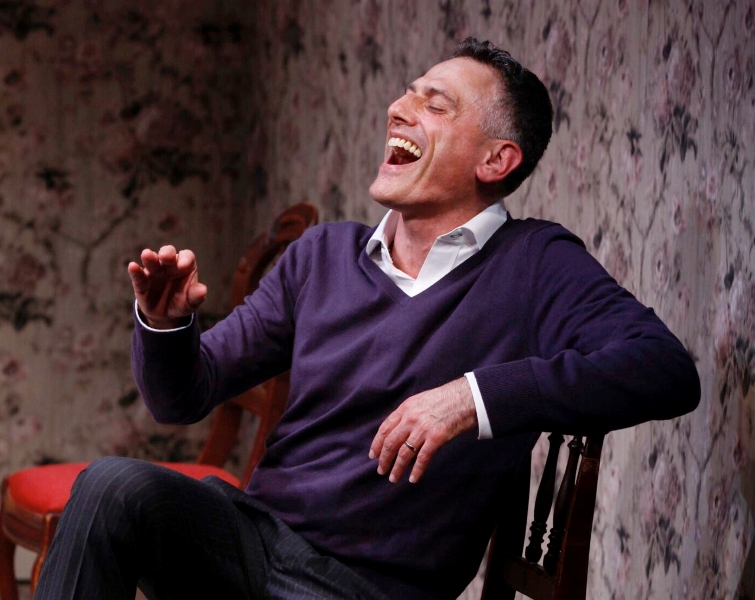THE PATSY
by Barry Connors
Directed by Jack Cummings III
Performed by David Greenspan
A Production of The Transport Group
Abrons Arts Center
Reviewed by David Spencer
The Patsy is, in a way, a double revival. It is both a revival of author Barry Connors’ 1925 drawing room comedy—a hit on Broadway at 245 performances, and again as a 1928 silent film—and of David Greenspan’s affectionate one-actor rendition of it, first presented off-Broadway in 2011.
Despite enough encomiums to mark it as notable, I offer the caution that this is very much an eye-of-the-beholder experience. I will state for the record that, for the most part, the audience around me seemed to be digging it…mostly. At times it was hard to gauge. And I’ll explain that.
Greenspan makes his entrance in a friendly and engaging enough way; after some pre-set instrumental jazz from a recording of the era, he bounds up an aisle from the back of the theatre, hops his butt onto the lip of the stage, lifts his legs , spins around, leaps to his feet and enters the set (Dane Laffrey), which is looks like a turn-of-the-20th-century drawing room compressed into a symmetrical box: six chairs, a bureau upon which sit two shaded lamps, beige floral wallpaper. Greenspan gives us title page info, including that it’s a comedy in three acts, carefully distilled stage directions, descriptions of the characters he’s portraying as “they” enter…and then we’re into it for 90 intermissionless minutes.
The quaintness of the play is both its charm and the reason why it’s never had a major NY revival in the near-century since its debut. The comedic doings of upper-class WASP types have only sporadically aged well—Philip Barry, perhaps; much more recently A.R. Gurney, who quite specifically treated the breed, his breed, as an ethnic group—and the jokes are as remote as the play’s cultural relevance.
So when only the odd pocket of laughter greets the lines at first, you can’t cleanly attribute that to Greenspan’s delivery or the material. After some significant time, the laughs are more solid and seem spread more communally. The material doesn’t seem to be getting better, so it must be that Greenspan is. Or it’s simply that the audience has made its pact with him and agrees to go on the ride. Fair enough.
But that pact is what will separate those who will and those who won’t.
I couldn’t make it. And I tried my damndest.
So this is not to tell you to avoid the show, nor even to take the word of my perception as a preview of yours…but rather to define the line of demarcation.
Greenspan is a multi-Obie-award-winning downtown theatrical icon and has been for decades. Until I got used to it, I tended to find his stage presence a bit unsettling. He’s quite slim, tallish, his face is a little drawn in, his sibilants have a touch of SH to them, and his speaking voice tends to ride a high register. He can seem a bit…alien and a bit alienated. And to be honest, it made him a perfect choice for Harold in the first NYC revival of The Boys in the Band, and the only genuinely worthy successor I’d ever seen to the role’s originator, Leonard Frey (likewise unlike anyone else, albeit his quality of wry aloofness was more accessible; and he was able to drop it and be charming, as evidenced by his Oscar-nominated Perchik the Taylor in Fiddler on the Roof, a role he had also played on Broadway; but I digress…)
His voice has a full range of expressiveness, in terms of having about an octave and a half available to him; but because it does sit so high, trying to distinguish six characters via subtle shift of pitch is less available to him. And he knows that at least instinctively, albeit probably consciously too; and must therefore compensate with other facets of his technique: exaggerated gruffness for the sympathetic matriarch with sometimes hands spread at the waist to remind us he has girth; way exaggerated hysteria for his melodramatic wife, hands up to her face; a little dance-step walkin’ for the young man and some jazziness in his cadences…it makes things broader, it diminishes human authenticity, and a little goes a long way. But in league with his director, Jack Cummiongs III, Greenspan knows that too, so he endeavors not to work all that too hard, and after a while to let a kind of shorthanding take over.
Which is the right and proper choice, yet it lessens the distinction between characters and that’s when it becomes entirely possible to lose the thread. And I did.
But I’ll add—ironically—I can see the charm in Greenspan now. Not from much to do with The Patsy itself, but from the way he made his entrance…and the way he mirrored it to make his exit. The unselfconscious playfulness of that was much more intriguing to me than all the prodigious effort spent in working his way through this old wheezer of a play. I wouldn’t mind seeing more of that guy.
Your mileage may very much vary.
